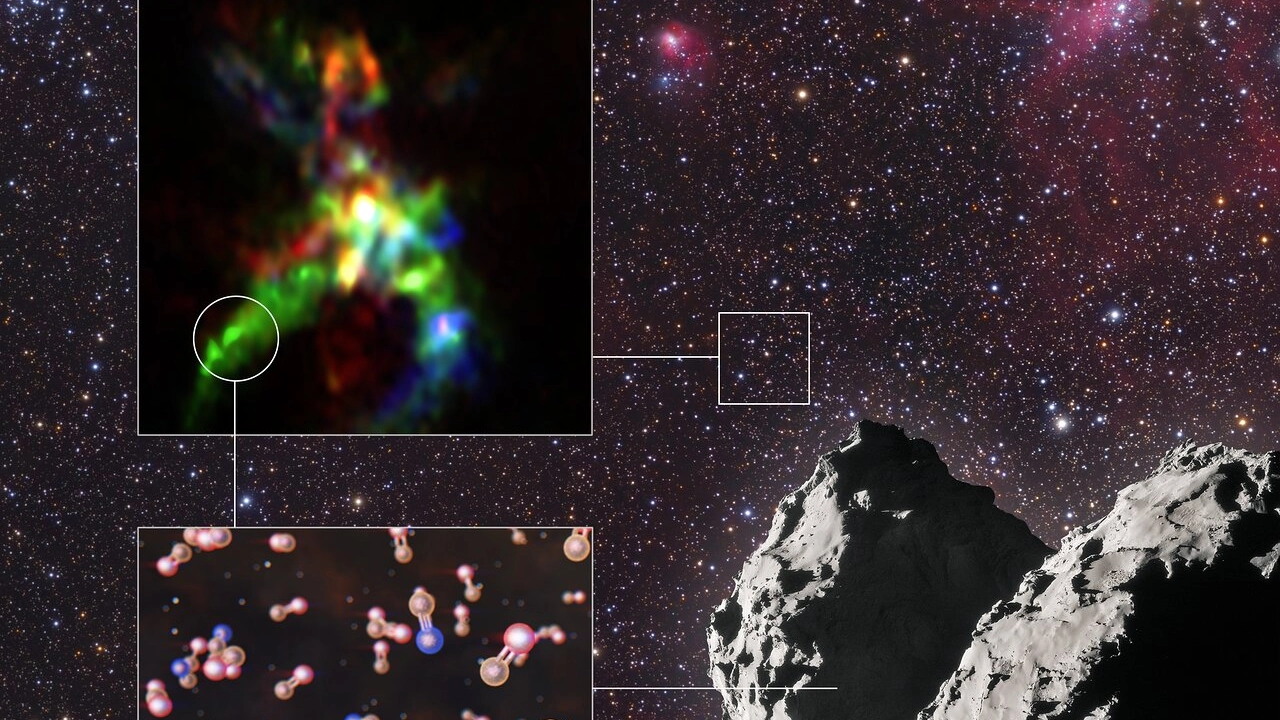
I risultati chiave di uno studio che ha rivelato la traccia interstellare del fosforo
Firenze, 15 gennaio 2020 - "La vita è apparsa sulla Terra circa 4 miliardi di anni fa, ma non conosciamo ancora i processi che l'hanno resa possibile", afferma Víctor Rivilla, autore principale di un nuovo studio pubblicato oggi dalla rivista Monthly Notices of the Royal Astronomical Society. I nuovi risultati di Alma (Atacama Large Millimeter/Submillimeter Array), di cui l'Osservatorio europeo australe (ESO) è partner, e dello strumento Rosina a bordo di Rosetta mostrano che il monossido di fosforo è un elemento chiave nel rompicapo sull'origine della vita. Con la potenza di Alma, che ha permesso uno sguardo dettagliato nella regione di formazione stellare AFGL 5142, gli astronomi sono stati in grado di individuare i luoghi in cui si formano molecole contenenti fosforo, come il monossido di fosforo. Nuove stelle e sistemi planetari sorgono in regioni, simili a nubi, formate da gas e polvere sparsi tra le stelle, rendendo queste nubi interstellari i luoghi ideali da cui iniziare la ricerca dei mattoni costitutivi della vita.
Le osservazioni Alma hanno mostrato che le molecole che contengono fosforo vengono create quando si formano stelle massicce. Flussi di gas da stelle giovani e massicce scavano cavità nelle nubi interstellari. Le molecole contenenti fosforo si formano sulle pareti della cavità, attraverso l'azione combinata di urti e radiazioni della giovane stella. Gli astronomi hanno anche dimostrato che il monossido di fosforo è la molecola più abbondante sulle pareti della cavità, tra tutte le molecole contenenti fosforo. Dopo aver cercato questa molecola nelle regioni di formazione stellare con Alma, il gruppo europeo è passato a un oggetto del Sistema Solare: l'ormai famosa cometa 67P/Churyumov–Gerasimenko.
L'idea era di seguire le tracce di questi composti contenenti fosforo. Se le pareti della cavità collassano per formare una stella, in particolare una non particolarmente massiccia, come il Sole, il monossido di fosforo può congelarsi e rimanere intrappolato nei granelli di polvere ghiacciata che rimangono intorno alla nuova stella. Ancor prima che la stella sia completamente formata, i granelli di polvere si uniscono per formare sassolini, rocce e infine comete, che diventano così trasportatori di monossido di fosforo. Rosina, acronimo che sta per Rosetta Orbiter Spectrometer for Ion and Neutral Analysis, ha raccolto dati da 67P per due anni, mentre Rosetta era in orbita intorno alla cometa. Gli astronomi avevano già trovato tracce di fosforo nei dati di Rosina, ma non sapevano di quale molecola si trattasse.
Kathrin Altwegg, investigatrice principale di Rosina e co-autrice del nuovo studio, ha avuto un suggerimento su quale potesse essere questa molecola dopo essere stata avvicinata a una conferenza da un astronoma che studiava con Alma le regioni di formazione stellare: “Mi disse che il monossido di fosforo sarebbe un candidato molto probabile, quindi sono tornata a verificare i nostri dati ed eccolo lì!” Questo primo avvistamento del monossido di fosforo su una cometa aiuta gli astronomi a stabilire una connessione tra le regioni di formazione stellare, dove la molecola viene creata, fino alla Terra. "La combinazione dei dati di ALMA e di ROSINA ha rivelato una sorta di filo chimico durante l'intero processo di formazione stellare, in cui il monossido di fosforo svolge il ruolo dominante", afferma Rivilla, ricercatore presso l'Osservatorio Astrofisico di Arcetri dell'INAF, l'Istituto Nazionale di Astrofisica italiano. "Il fosforo è essenziale per la vita come la conosciamo", aggiunge Altwegg. "Dato che le comete hanno probabilmente fornito grandi quantità di composti organici alla Terra, il monossido di fosforo trovato nella cometa 67P potrebbe rafforzare il legame tra le comete e la vita sulla Terra." Questo affascinante viaggio ha potuto essere documentato grazie alla collaborazione tra astronomi. "Il rilevamento del monossido di fosforo è stato chiaramente ottenuto grazie a uno scambio interdisciplinare tra telescopi sulla Terra e strumenti nello spazio", commenta Altwegg.
E c'è anche la Toscana in questa ricerca con Leonardo Testi, astronomo dell'Eso e responsabile europeo delle operazioni di Alma, che conclude: “Comprendere le nostre origini cosmiche, tra cui quanto siano comuni le condizioni chimiche favorevoli all'emergenza della vita, è uno dei temi principali dell'astrofisica moderna. Mentre Eso e Alma si concentrano sulle osservazioni di molecole in giovani sistemi planetari distanti, l'esplorazione diretta dell'inventario chimico all'interno del nostro Sistema Solare è resa possibile dalle missioni Esa, come Rosetta. La sinergia tra le strutture terrestri e spaziali all'avanguardi a livello mondiale, attraverso la collaborazione tra Eso ed Esa, è una risorsa preziosa per i ricercatori europei e consente scoperte rivoluzionarie come quella riportata in questo articolo".

